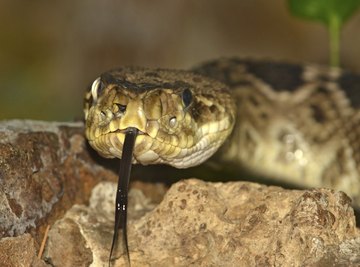
Illinois has 39 snake species within its boundaries, but the majority live in the warmer southern region of the state. Snakes in North Illinois generally contend with colder temperatures than their Southern Illinois counterparts. Some of these Midwestern snakes are threatened due to urban growth (in the Chicago and Rockford areas, for example) and more general habitat loss or alteration.
Water Snakes
Water snakes spend the majority of their time in or near freshwater lakes, marshes, swamps and rivers, where, because of somewhat similar markings, they’re commonly mistaken for the venomous and analogously water-loving cottonmouth (which only inhabits central and southern Illinois) and – in the case of Illinois’s diamondback water snake – for rattlesnakes. Water snakes, however, lack venom (not to mention rattles). Several varieties of water snake inhabit North Illinois: the widely distributed northern water snake and the more restricted plainbelly and diamondback water snakes of the Mississippi Valley. (The broad-banded and Mississippi green water snakes, meanwhile, call southern Illinois home.)
Water snakes aren’t the only aquatic or semiaquatic serpents native to North Illinois, incidentally: For example, two kinds of crayfish snake – the queen snake and Graham’s crayfish snake – inhabit some of the region’s waterways, while garter snakes also readily forage around wetlands and streams.
Venomous Snakes
According to the Illinois Department of Natural Resources, Illinois hosts four venomous snake species: the cottonmouth, copperhead, timber rattlesnake and eastern massasauga. Of these, only the two rattlesnakes – the timber rattler and massasauga – may inhabit North Illinois, though they're extremely rare in this part of the state. The massasauga, which resides along rivers and in marshes and swamps, is listed as endangered in Illinois; the timber rattlesnake is threatened. All of Illinois' venomous snake are pit vipers; they received this name due to the physical “pit” between the snakes' eyes and nostrils, which serves as a sensory organ. Venomous snakes kill their prey by biting them with their fangs, which contain paralyzing venom.
Threatened Species
Besides the two rattlesnakes, several other North Illinois snakes fall on the state’s threatened and endangered species list. Classified as threatened include Kirtland’s snake – found around the Greater Chicago area in wet prairies and grassy stream and pond edges, and faced with substantial habitat loss – and the western hognose snake, primarily found in Northwest Illinois and threatened by the loss of its preferred habitat of sand prairies. (The eastern hognose snake roams a much larger range in North Illinois.)
Cold-Tolerant
Certain snake species have a higher degree of cold tolerance than other snakes. This means they are able to withstand colder temperatures; thus, these snakes do not have to hibernate as long as other snake species. Illinois' two garter snakes – the plains garter snake and common garter snake – belong to this category: These species often break up their winter hibernation by basking outside in warm, sunny weather, and tend to emerge early in the spring..
References
About the Author
Skip Davis has been writing professionally since 2005. His work has appeared in "Southern Literary Magazine," on various websites and in graphic panels at the Jackson Zoological Park in Jackson, Miss. Currently living in Southern California, Davis received his Bachelor of Arts in theater at Belhaven College.
Photo Credits
thewizzthatwoz/iStock/Getty Images
